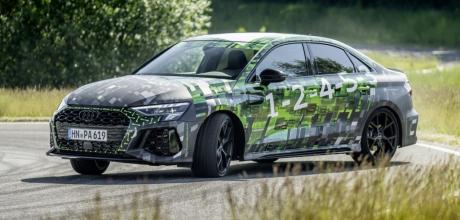2023 Audi’s next RS3
Updated Audi RS3 gains active rear-axle torque vectoring and drift mode
LATERAL THINKING
A full reveal of Audi’s hotly anticipated RS3 minus camo is due imminently; however, Audi has released a trove of technical details for the next-iteration of RennSport’s compact street fighter.
Drastic exterior and interior facelifts are expected, but while much of the RS3’s mechanical ingredients remain the same – a host of new tech promises the most capable and dynamic package in the nameplate’s 10-year history. Still based on Volkswagen Group’s MQB-architecture and retaining the familiar 2.5-litre five-cylinder turbocharged engine, peak power remains capped at 294kW while torque increases by 20Nm to 500Nm, arriving earlier and sticking around longer, between 2250rpm and 5600rpm.
Alone, those mechanical developments may seem a little underwhelming, but the RS3 also debuts a number of significant technological advances for the brand; primarily the new ‘RS Torque Splitter’ rear axle.
A very similar unit has already been seen underneath the new Mk8 Golf R’s rear end, and sees a mechanical differential mounted as part of the rear axle, with an independent electronically controlled multi-plate clutch connecting to each rear driveshaft.
While the outgoing Haldex rear end allowed up to 50 per cent of engine torque to be sent rearward, the new fully variable system is able to cater for 100 per cent of drive to either rear corner. Depending on the drive mode, the rear differential will aim to minimise both under and oversteer, while aiding corner entry and early power application at exit.
Two new drive modes also make their debut, comprising of RS Performance and RS Torque Rear modes, beyond the familiar Comfort, Auto, Dynamic, Efficiency and Individual modes.
RS Performance is an even sharper step up from Dynamic mode, specifically optimised for the race track and tuned to the new factory-option Pirelli P Zero Trofeo R semi-slick tyres.
Meanwhile RS Torque Rear mode leverages the rear differential’s ability to deploy up to 100 per cent of drive to a single rear-wheel, becoming a basic drift mode. Now with seven drive modes to choose from, the new Audi RS3 offers even more personalisation between dynamic situations with distinct configurable tuning curves for the powertrain, steering assistance, adaptive dampers and fully variable exhaust flaps.
Combined, these elements offer distinct personas between the available drive modes, with Comfort and Efficiency distributing drive between all four wheels with priority given to the front axle; while Auto mode balances torque between all four wheels and sharply quells yaw.
Dynamic mode, previously the most focused setting, sends as much torque as possible to the rear, whereas RS Torque Rear mode is an extension of this, and RS Performance, best reserved for seeking fast lap times.
The modular Vehicle Dynamics Controller (mVDC) is lifted from the A3 and S3, and handles rapid communication between the new rear axle’s two control modules, adaptive dampers (if optioned) and wheel-selective torque control, to maximise the desired feedback, speed and handling depending on the drive mode application.
While power output remains unchanged for the new RS3, like peak torque, the five-pot’s peak power is delivered sooner (by some 250rpm), helping improve the 0-100km/h sprint by three tenths to a claimed 3.8 sec.
In base trim, V-Max is limited to 250km/h, although 280km/h is available as an option; so too is an optional RS Dynamic package which, combined with carbon ceramic brakes, allows for a top speed of 290km/h.
The seven-speed dual-clutch gearbox gains snappier gear ratios, and a reinforced right-angle drive to cope with the increased torque. An optional RS Sport Suspension Plus package includes adaptive damper control boasting three further tuning curves for Comfort, Balanced and Sport situations. Audi Sport’s quest for maximum traction continues in fine detail, with almost one degree of additional negative camber dialled in to the front axle, while negative camber at the rear increases by half a degree in order to maximise the tyre’s contact patch when placed under hard lateral loads.
For what is likely to be the final combustion-only RS3, the changes Audi has made under the skin keep the key ingredients which made the model so popular in the first place, while adding key upgrades to improve its dynamic abilities. Sadly, the future shelf life of the beloved five-cylinder now has a clear end date, meaning this is likely going to be as good as it gets in terms of punch from the charasmatic unit Though as a small silver lining, what may possibly be the final fivepot RS3 we ever see is also shaping up to be the most capable and dynamic one yet.
BELOW Active rear axle torque vectoring making singlepeggers cool? ABOVE The bones of the RS3 remain the same but there’s some clever tech beneath the skin.


